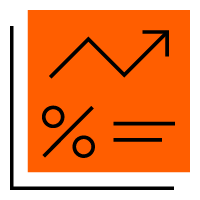According to our Feb. 7, 2023, report of 74 million Credit Karma members with credit cards, Credit Karma members held more than $397 billion in credit card debt across more than 318 million open accounts. Average credit card debt by member was $6,469 — a 4.4% increase from May 2022.
Gen Z and members with credit scores of 660 and lower saw the highest growth in average debt from May 2022 to February 2023.
Read on for more findings, including a breakdown of credit card debt by generation, state and more. Learn more about our methodology.
Average credit card debt by generation
Generation X and baby boomer Credit Karma members, respectively, hold the highest average credit card debt, while Generation Z has the least. The average credit card debt carried members of Gen X is nearly triple the average credit card debt carried by members of Gen Z. But while Gen Z has the lowest average card debt, they saw the highest growth (7.4%) in average card debt from May 2022 to February 2023, followed by Millennials.
Generation X and baby boomer Credit Karma members, respectively, hold the highest average credit card debt, while Generation Z has the least. The average credit card debt carried by baby boomers and members of Gen X is around triple the average credit card debt carried by members of Gen Z.
| Generation | Average credit card debt February 2023 | Average credit card debt May 2022 | Growth in average card debt |
|---|---|---|---|
| Generation Z (Born 1997–2012) | $2,781 | $2,589 | 7.4% |
| Millennials (Born 1981–1996) | $5,898 | $5,575 | 6.0% |
| Generation X (Born 1965–1980) | $8,266 | $7,923 | 4.3% |
| Baby Boomer (Born 1946–1964) | $7,464 | $7,285 | 4.7% |
| Silent Generation (Born 1928–1945) | $5,649 | $5,602 | 0.8% |
Average credit card debt by state
Alaska tops the list, with members having the highest average credit card debt at $8,139, followed by Hawaii ($7,444) and New Jersey ($7,306). Members in Mississippi have the lowest average debt — $5,259. Kentucky is close behind with an average credit debt of $5,455.
Here is credit card debt by state, sorted alphabetically.
| State | Credit Karma members’ average credit card debt | Rank (1 being most debt) |
|---|---|---|
| Alabama | $5,647 | 45 |
| Alaska | $8,139 | 1 |
| Arizona | $6,198 | 22 |
| Arkansas | $5,600 | 47 |
| California | $6,952 | 8 |
| Colorado | $6,710 | 11 |
| Connecticut | $7,032 | 6 |
| Delaware | $6,429 | 19 |
| Florida | $6,783 | 10 |
| Georgia | $6,563 | 15 |
| Hawaii | $7,444 | 2 |
| Idaho | $5,737 | 42 |
| Illinois | $6,615 | 14 |
| Indiana | $5,601 | 46 |
| Iowa | $5,732 | 43 |
| Kansas | $6,122 | 26 |
| Kentucky | $5,455 | 49 |
| Louisiana | $5,872 | 36 |
| Maine | $5,788 | 41 |
| Maryland | $7,248 | 4 |
| Massachusetts | $6,700 | 13 |
| Michigan | $5,812 | 40 |
| Minnesota | $6,166 | 25 |
| Mississippi | $5,259 | 50 |
| Missouri | $5,869 | 38 |
| Montana | $6,026 | 30 |
| Nebraska | $6,188 | 23 |
| Nevada | $6,548 | 16 |
| New Hampshire | $6,545 | 17 |
| New Jersey | $7,306 | 3 |
| New Mexico | $5,871 | 37 |
| New York | $7,029 | 7 |
| North Carolina | $5,969 | 33 |
| North Dakota | $6,347 | 21 |
| Ohio | $5,879 | 35 |
| Oklahoma | $6,030 | 29 |
| Oregon | $6,113 | 27 |
| Pennsylvania | $6,180 | 24 |
| Rhode Island | $6,498 | 18 |
| South Carolina | $5,989 | 31 |
| South Dakota | $5,987 | 32 |
| Tennessee | $5,832 | 39 |
| Texas | $6,707 | 12 |
| Utah | $6,040 | 28 |
| Vermont | $5,945 | 34 |
| Virginia | $7,174 | 5 |
| Washington | $6,869 | 9 |
| West Virginia | $5,674 | 44 |
| Wisconsin | $5,593 | 48 |
| Wyoming | $6,383 | 20 |
Higher average credit card debt may be due, in part, to where members live. Those with the lowest average credit card debt tend to live in states we have identified as some of the cheapest states to live in. Conversely, those with the highest average debt live in some of the states ranked the most expensive.
Average credit card debt by credit score
Credit Karma members with higher VantageScore 3.0 credit scores tend to have lower average credit card debt. Those with scores of 601 to 660 have the highest average debt — $9,295 — while those with scores of 781 to 850 average $3,345 in credit card debt.
Those with scores of 300 to 600 are an exception, with $5,684 in average card debt.
Members with lower scores saw the highest growth in average card debt from May 2022 to February 2023, while those in the highest score range saw the least.
| VantageScore 3.0 score band | Avg. total credit card debt February 2023 | Avg. total credit card debt May 2022 | Growth in avg. card debt | Avg. of next card payment | Avg. account age (in months) |
|---|---|---|---|---|---|
| 300–600 | $5,684 | $5,398 | 5.3% | $196 | 222.7 |
| 601–660 | $9,295 | $8,819 | 5.4% | $260 | 352.4 |
| 661–780 | $6,720 | $6,456 | 4.1% | $172 | 443.3 |
| 781–850 | $3,345 | $3,253 | 2.8% | $94 | 899.1 |
A longer account history and lower credit card utilization can help improve credit scores.
Average monthly credit card payment
The average next credit card payment for Credit Karma members is $181. But the average payment is naturally higher for those with higher total credit card debt. For example, Gen X members average $8,266 in credit card debt and have an average next payment of $233. On the flip side, Gen Z members have an average of $2,781 in total card debt and an average next payment of only $83.
Tips for managing credit card debt
Mounting credit card debt can feel overwhelming, but the good news is that there are things you can do to find credit card relief. Here are some suggestions.
Negotiate with your credit card company
If you’ve already missed a payment or are about to, reach out to your credit card issuer. The company may be willing to work out a more manageable repayment plan for you. Some offer forbearance or hardship programs that could reduce your monthly payment or postpone a certain number of payments. You may even be able to settle your debt for a lower amount if the company determines that you aren’t able to pay back the full amount.
If you are able to work out an alternate repayment plan with your creditor, be sure to ask for the plan in writing.
Consider a personal loan to consolidate credit card debt
Consolidating your credit card debt into a personal loan may help you pay your debt off faster. With a debt consolidation personal loan, you make a single payment each month, and your interest rate is fixed, meaning it won’t change based on an index. Another benefit: Interest rates on personal loans tend to be lower than credit card rates. This can help lower your overall monthly payment and/or allow you to pay down your debt more quicky.
Take note that personal loans may come with fees, such as an origination fee or paperwork processing fee. Consider these fees when determining whether you might be able to save money with debt consolidation.
Methodology
To determine averages across credit card debt, we analyzed the accounts of more than 74 million U.S. Credit Karma members who had been active on the site within the last 36 months and who have credit card accounts. All aggregate data analyzed was pulled on Feb. 7, 2022. The data came from members’ TransUnion credit reports, and the averages were based on information from the last 90 days. For the purposes of this analysis, credit card debt is defined as any unpaid balance existing on members’ open credit cards in aggregate at the time the data was pulled. All numbers in this report were rounded to the nearest whole.








